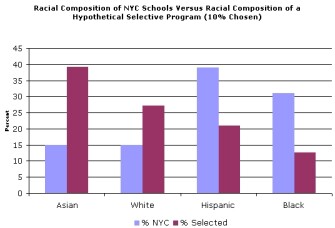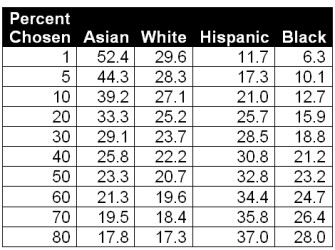skoolboy has explained, much more eloquently than I can, why achievement gaps matter even if the scores of white, African-American, Hispanic, and Asian students are all rising equally:
There are a great many social institutions that sort and rank individuals on the basis of test scores and the competencies they represent. Most of these institutions don’t have an unlimited number of positions or slots—rather, individuals are competing against one another for access. When these institutions rely on test scores, and there is an achievement gap among racial/ethnic groups on these tests, the lower-scoring group will be underrepresented. Raising everybody’s scores doesn’t change the rankings of individuals, which is the only way to change the representation of minority groups among those who are selected. Only by reducing the achievement gap can we increase the chances that members of racial/ethnic minority groups can get ahead in society via selective social institutions.
In K-12 and postsecondary education, examples of these selective processes abound. Kindergarteners are often placed in reading groups when they first arrive at school, students are selected to be part of gifted and talented or magnet programs, and even less selective colleges have limited capacity. The same processes apply in the workplace. Whether you are looking for a job at Walmart or Goldman-Sachs, there are usually more applicants than positions.
Taking inspiration from the conclusion of skoolboy’s earlier analysis, I performed a basic simulation to demonstrate how black and Hispanic students fare in selection processes given existing NYC achievement gaps. I randomly generated 100,000 student scores, which roughly represents the size of a NYC cohort. In NYC schools, approximately 15% of students are Asian, 15% are white, 39% are Hispanic, and 31% are African-American. I generated these data to mirror the achievement gaps that exist in 8th grade math NAEP scores in NYC: the average African-American and Hispanic student scores .83 and .72 standard deviations below the average white score, respectively, and the average Asian student scores .28 standard deviations above it. I then asked what the racial composition of selected students would look like if we selected 5% of students, 10% of students, and so on.
Let’s start with a relatively selective process. Imagine that we choose the top 10% of students in NYC for a gifted and talented program based solely on their test scores. The graph below shows the difference in the percentage of students that would be selected in each racial group compared to their representation in the NYC student population. Though NYC schools are only 30 percent white and Asian, 66 percent of selected students would be white or Asian under this scenario. Only 17% would be Hispanic and 10% would be black.

Because of the achievement gap, black and Hispanic children are left behind in many selection processes that potentially - and significantly - affect their life chances. When we make these processes even more selective - think, for example, about admission to schools like Stuyvesant or Bronx Science - white and Asian students will be even more overrepresented, as the table below demonstrates.
And this is not only relevant to very selective institutions. Below, I move the cutoff point for our selective program progressively up. Even if 50% of students would be given a slot, white and Asian students still represent 44% of selected students, though they are only 30% of the population.

In short, the achievement gap has real implications for black and Hispanic kids as they move through their educational careers: they are more likely to be placed in low ability groups in integrated schools, less likely to be selected for gifted and talented programs, and less likely to attend the college of their choice. And, I stress again, this applies to both very selective and relatively non-selective institutions. Gains in proficiency that do not also close achievement gaps on continuous measures do little to help black and Hispanic kids get ahead.
See previous takes from Mike Petrilli and Jay Mathews here.
A few notes: To keep this simple, I assumed that the scores of all groups follow a normal distribution with equal variances. Since achievement gaps are often larger at the top of the distribution than in the middle and bottom, white and Asian students have an even larger advantage than they appear to based on this simulation.